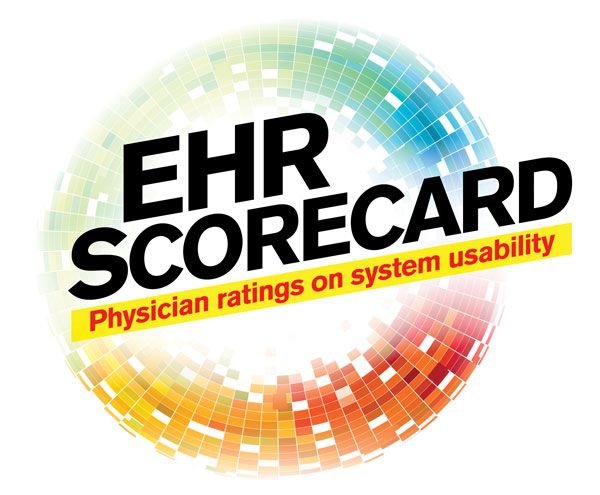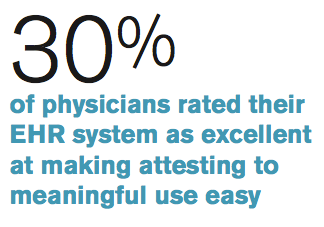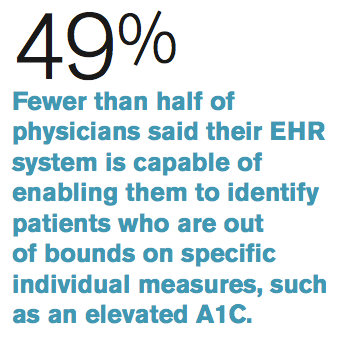Article
Satisfaction with EHR systems grows among physicians
Medical Economics' exclusive survey gathers physician usability ratings of the top EHR systems in five key areas: quality of care, meaningful use, patient portal, technical support, and clinical support.

Considering the dissatisfaction that many physicians have expressed about electronic health records (EHRs), you might think that most doctors hate these systems. But, according to an exclusive Medical Economics survey, 55% of physicians are fairly or very satisfied with their EHRs, and 54% believe they have helped improve the quality of care.
Forty-five percent of respondents said that EHRs have had a positive financial impact on their practices. Most of that is probably related to the Meaningful Use incentives from the government, says Michelle Holmes, MBA, a Seattle-based principal with ECG Management Consultants. “I don’t think it’s the norm for people to say the profitability of their practice is better after EHR implementation than before it, from a productivity and cost perspective.”
About 80% of Medical Economics’ respondents had EHRs, and only 11% of those said they were planning to replace their system within the next 12 months. On the other hand, only 55% said they would recommend their EHR to colleagues. The satisfaction of physicians with particular aspects of their EHRs varied a great deal, and the market leaders were not necessarily the most popular among their customers.
Since the survey sample was skewed toward small and medium-sized private practices, this doesn’t surprise Holmes. The physicians in these practices probably selected the cheap and free products from smaller vendors, she notes. “They’re not using a system that someone else selected on their behalf.”
Internist Edward Gold, MD, an experienced EHR user who practices in a 59-doctor group based in Emerson, New Jersey, says many physicians prefer the inexpensive EHRs “because they’re simple, and they’re meant to be easy to use. But they don’t accomplish all the things that need to be accomplished for Meaningful Use. They don’t give you the reports you need for the medical home, the reports you need to belong to an ACO. They don’t have the interoperability or the connectivity that’s required. They’ll do for keeping an office record, but they just provide the basics.”
This coverage highlights five EHR usability areas important to physicians: Quality of care, Meaningful Use, patient portals, technical support and clinical support.
Next: Attestation tools
Attestation tools
Of the respondents who used EHRs, 78% had attested to Meaningful Use in the past year. Sixty-eight percent said the ability of their EHR to enable them to attest to meaningful use was “good” or “excellent.”
Internist Kenneth Kubitschek, MD, a partner in North Carolina Internal Medicine in Asheville, North Carolina, and Gold both said their EHRs made it fairly easy to attest in Meaningful Use stage 1. But like most doctors, they’re having trouble with some stage 2 requirements for reasons that have little to do with the quality of their EHRs. Their challenges include getting patients to use patient portals and exchanging care summaries at transitions of care in an environment where interoperability remains limited.

One area in which EHRs seem to have made progress is clinical decision support (CDS). Sixty-eight percent of our respondents had a positive opinion of their ability to use their EHR to implement at least five CDS support tools, which is required for Meaningful Use stage 2.
Holmes notes that the CDS tools in current EHRs go well beyond pop-up alerts in electronic prescribers that warn doctors about drug interactions, wrong dosages, and so forth. CDS is built into the documentation templates of many EHRs, she points out. For example, there may be prompts regarding out-of-range information on vital signs.
Some of the prompts regarding practice guidelines, such as initial medications suggested for a patient with newly diagnosed diabetes, are quite helpful, Kubitschek says. But many care planning prompts, such as suggested recommendations to an overweight patient, are unnecessary, he adds.
Peter Basch, MD, medical director for ambulatory health and health IT policy at MedStar Health in Washington, D.C., observes that EHRs certified for Meaningful Use must contain certain types of CDS tools. These include reminder alerts, he says. But he feels that vendors have much further to go in this direction. For one thing, alerts that are fired improperly can lead to alert fatigue. Also, he notes, smart features could be developed to suggest diagnostic tests for a particular problem and to find out whether similar tests had been performed earlier.
Next: Connecting with patients and vendor customer service
Connecting with patients
About six in ten respondents gave a “good” or “excellent” rating to the usability of their patient portal and the ease of updating EHR data on the portal. This is important to many practices because of Meaningful Use stage 2. The government incentive program requires that eligible professionals provide 50% of patients with online access to their records. They must also ensure that 5% of their patients view, download or transmit their health information online. And they have to demonstrate that they can exchange secure messages with patients.

The main barrier to achieving these goals is not the technology, Holmes notes. “Most portals aren’t difficult for the practice or the patient to use. The hurdle is getting people to use them.”
Aside from that, Kubitschek says, his patient portal works very well. “When I do my labs and other stuff, the information uploads automatically as soon as I sign it. And the patients are getting it, because we’re talking to them. It has their problems, allergies, medications, and immunizations. We get messages back and forth from the patients. I’ve been pretty pleased with it.”
Another benefit, he adds, is that patient messages come right into an EHR inbox, and physicians can decide to whom those should be directed. He has his nurse triage the patient communications. He can then reply directly to a patient message or send it back to his nurse, and can choose whether to save it to the chart.
Vendor customer service
About 60% of the respondents rated the quality and amount of EHR training and the vendor’s ability to solve technical problems as “good” or “excellent.” Around the same percentage gave a thumbs-up to the quality of the interface between their EHR and practice management system (PMS), if they had non-integrated systems.
On the other hand, many respondents gave their vendors fair or poor scores for their ability to solve technical problems (30%), the level of support the practice received in configuring the EHR (29%), the quality and amount of training (28%), and the ability to customize their EHR (36%).

Basch believes that increasing transparency and competition have induced vendors to offer packages of software, training and implementation that are better than they were. Holmes, in contrast, speculates that many physicians rate their vendors highly because they don’t know how much of the support work is being done by their organization’s IT staff or by “super-users” in their own offices.
Gold and Kubitschek both give their vendors fairly high marks for training and technical support. But Gold notes that training varies greatly among EHR suppliers. “The basic problem that most doctors have with EHRs has to do with the inadequacy of training. The lower level EHR vendors will give you six hours of training online. The more training you get, the more it costs, and doctors don’t like costs. Doctors never invest enough in training,” he says.
His own group he adds, is big enough to afford its own IT person, who trains new staff and provides ongoing training to the doctors and staff members. “It’s never once and done,” he points out. “In a higher-end system, there are so many bells and whistles that people are unaware of that could make their lives a lot easier. It’s a continuous process of educating people.”
Next: Quality reporting and usability

Quality reporting
Seventy-nine percent of EHR users said their systems could generate quality reports. That’s about the same percentage of respondents who said they’d attested to Meaningful Use, which requires quality measures.
But these statistics obscure the difficulties that some users have in using their EHRs to report on quality measures, Gold says. “In some systems, it’s easy to generate reports,” he notes. “Others require the involvement of the vendor, which charges the physicians to do this.” Moreover, if doctors and practice staff aren’t specifically trained to produce reports, it might be very challenging for them. Gold himself finds it fairly simple, he adds, because his system provides a dashboard for this purpose.
READ: Financial penalties nearing for physician incentive programs
Fairly high numbers of respondents said their EHRs could generate clinical reports on subgroups of patients (63%), identify patients who were out of bounds on specific measures, such as diabetic patients with elevated A1c levels (49%), and send alerts to providers and care managers about patient care gaps (45%). Eighty-seven percent of EHR users said their systems could do at least one of these tasks.
Do many physicians use this data and the related workflow features to improve care and manage population health? Basch doubts it. The business case for using health IT to improve quality, he says, is still lacking in most practices.
For Kubitschek and his colleagues, however, the challenge is much more immediate. They’re too busy attesting to Meaningful Use stage 2 and getting all their quality reports right to worry about using the data for quality improvement, he says.
Usability
Nearly two-thirds of respondents gave above-average scores to their EHRs on two markers for usability: ease of ordering tests and medications, and ease of moving between sections of EHRs. And 53% of respondents rated their vendor’s ability to customize their EHRs as “good” or “excellent.”
Regarding customization, Holmes believes that most physicians can’t readily distinguish between what their own IT people or other staffers do and what their vendor does. But employed physicians have a more difficult time getting things changed in their EHR than do private practice doctors, she says, because of the former’s need for organizational approval. So she thinks the usability scores reflect “the amount of control that physicians have over their systems in smaller practices.”
That doesn’t explain the popularity of cloud-based EHRs, which allow little customization. Holmes thinks that practices that choose those products see other advantages in them. Among other things, she says, they’re generally simpler to implement, learn and navigate than are more complex client-server programs.
Basch gives credit to EHR vendors for improving the usability of their products in some ways. For example, he notes, physicians can order a test or a prescription anywhere in the workflow in many systems, rather than having to be at a certain point in the process.
Kubitschek, says that the usability of EHRs has vastly improved since he started using one in 1995. While the vendors haven’t made much progress in the past three years because of their focus on Meaningful Use, he says, he’s recently seen some innovations that have made his EHR more user-friendly.
Next: Practice management systems and optimization

Practice management systems
Because finances are the lifeblood of practices, the practice management system component of EHRs-or the standalone PMS bolted to an EHR-is vitally important. But just 61% of respondents gave good or excellent scores to the ability of their system to post electronic remittance advice (ERA) correctly; 53% did the same for their system’s ability to provide feedback on coding errors.
“I thought those numbers should be higher,” Holmes says. “If you have a PMS that can’t post an ERA correctly, you have a problem. That’s core functionality that’s been there for years.”
Some practices are still clinging to old billing systems that are no longer supported by their vendors, she notes. In addition, a substantial portion of the practice universe isn’t even using ERA yet, according to a recent report.
Optimization
The bulk of responses to questions about the respondents’ EHRs ranged from neutral to slightly positive. To Holmes, this indicates that much more is buried beneath the surface of the survey results. For example, she says, she’d like to know how much IT support the respondents had available to them and how much of the EHR’s functionality they’re actually using.
Basch takes a more optimistic view. Considering all of the difficulties doctors encounter in learning how to use an EHR and changing how they work, he says, “I’d expect people to feel neutral to slightly positive.”
The determining factor in how an individual physician or a group feels about an EHR-assuming it has decent functionality-is the degree to which the doctors have optimized their system so that it helps them become more efficient and deliver better care. Says Basch, “If you take a less than optimal tool and try to optimize it, you can get better results.”





